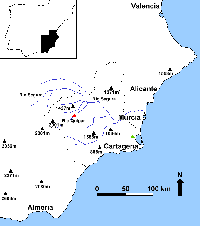
Figure 1: site locations

Figure 2: climate information
Sima de las Palomas del Cabezo Gordo and Cueva Negra del Estrecho del Río Quípar, lie 90 kilometres apart in contrasting environments(Figure 1, Figure 2).

Figure 1: site locations

Figure 2: climate information
Both have middle palaeolithic (Mousterian) assemblages and Neanderthal hominids, though at Sima de las Palomas Neanderthal folk 50,000 years ago were preceded during the last interglacial by even more archaic hominids. First, though, let's take a look at some of the kinds of scientific puzzles that hover in the background.
Did Neanderthals arise in Europe? Maybe from early Middle Pleistocene forebears (Homo antecessor-H. heidelbergensis) that developed via later Middle Pleistocene forms (H. steinheimensis-H. neanderthalensis) down a line that, already in late Lower Pleistocene times, had diverged from our own African H. erectus-H. sapiens ancestry (as had a H. erectus-H. soloensis lineage that became extinct in Asia). If so, late Neanderthals in France and Spain 35,000-30,000 years ago were perhaps an atavistic species with no more tendency to mate, regularly and successfully, with modern-looking H. sapiens settlers in the Near East and Europe than foxes have with dogs. That's a 'strong' interpretation (cf. Tattersall 1995a, 116; 1995b, 219, 231), though a weak' one doesn't altogether rule out a remote possibility of unequal interbreeding across a behavioural gulf separating two interfertile species (Stringer and Gamble 1993, 193; Stringer 1989). These could have been overlapping interfertile 'semispecies'. (These often do look rather different - unlike overlapping 'sibling species, which resemble each other more though they never interbreed.)
Other palaeoanthropologists have misgivings about conjuring up insurmountable reproductive barriers between Middle-Upper Pleistocene hominid taxa, let alone conjecturing them to be biologically incompatible species rather than highly distinctive populations of a polytypic one. Maybe at most they were 'subspecies'. (Subspecies are interfertile reproductive isolates in a species, whose territories often overlap but need not do so.) Did Middle Pleistocene people form a single biological species of ancient humans worldwide (Homo cf. sapiens), undergoing evolution from archaic forebears (Homo cf. erectus) in different ways though capable of interbreeding? This 'strong' view assigns us (Homo sapiens) a multiregional evolution (Wolpoff 1992; Wolpoff and Caspari 1997, 270-313). A 'weak' version offers a mix-and-match of Quaternary regional continuity - particularly in Africa, with replacement elsewhere producing differential hybridization during Upper Pleistocene times (brauer89>Bräuer 1989; 1992).
Our Sima de las Palomas remains impinge on the wrangle because Neanderthals were still absent there in last interglacial times when they certainly were present at Krapina in Croatia and elsewhere in Europe. If Neanderthals were to linger late in France and Spain, might not previous hominids have done likewise, long before? Maybe in Spain, upper palaeolithic replacement had been preceded by one during the middle palaeolithic when Neanderthals moved into regions where their less evolved forebears once lived.
Evolutionary biology certainly accepts that lineages become extinct, only to be replaced by others that become extinct in turn. This is disconcerting for prehistorians and palaeoanthropologists who like to deploy sites, hominid fossils, and palaeolithic assemblages, so as to portray an unstoppable evolutionary progressive march (even if only down a European side-track from H. heidelbergensis to H. neanderthalensis). Because European middle palaeolithic artifacts go back over 250,000 years, and because Near Eastern ones were handled by both Neanderthals and early modern humans in early Upper Pleistocene times, we should stop hankering after either human evolutionary "progressivism" or the cosy oversimplification that Mousterian tools were Neanderthal handiwork alone.
Evolutionary biologists and archaeologists alike find it hard to fit hominid palaeoethology (ancient behaviour) into the received wisdom of their respective disciplines. Evolutionary biologists are trained to interpret behaviour such as separate mating calls as enough to consign similar animals to separate species - more than enough if they show morphological differences. Archaeologists expect, with actualistic simple-mindedness (cf. Murray and Walker 1988), to infer human demographic continuity from homogeneity of material culture in time and space.
Processualist palaeoeconomic approaches, which attempt to discover long-vanished patterns of resource-procurement and their corresponding social processes, may afford insights into hominid behaviour if we compare prehistoric patterns with ape behaviour on the one hand and contemporary hunter-gatherers' on the other. But because people and chimpanzees share a distant common ancestor, evolving palaeoecological and palaeoeconomic parameters of hominid palaeoethologies mean these are unlikely to reflect behaviour of today's chimps or hunter-gatherers. That is why it is useful to study not one site but at least two sites in contrasting surroundings: comparing them may uncover not only regularities between them, but also irregularities that may not have been foreseen from actualistic comparison of each alone with supposedly analogous modern examples.
We cannot yet pretend to be able to evaluate alternative interpretations of human evolutionary pathways in Europe from the limited field-research undertaken at our sites to date. We firmly believe, however, that, long before attempting to draw inferences, findings should first be assessed in terms of the context of both their discovery and the methods or techniques appropriate to it. We therefore offer a warts-and-all preview of preliminary results of ongoing fieldwork. We eschew a theoretical discussion for that reason, and also because far too many unsupported conjectures about Neanderthal evolution are endlessly bandied about (especially in WorldWideWeb discussion and news groups!) and this imbalance badly needs redressing with a firm emphasis on substantive archaeological and palaeoanthropological findings. These are tediously unavoidable in order to show whether a skeletal find is Neanderthal or not, or whether it came from a sealed stratigraphical context or not - because precision in giving results affects accuracy in offering future interpretations about them.
© Internet Archaeology
URL: http://intarch.ac.uk/journal/issue5/walker/1.0.html
Last updated: Wed Dec 23 1998